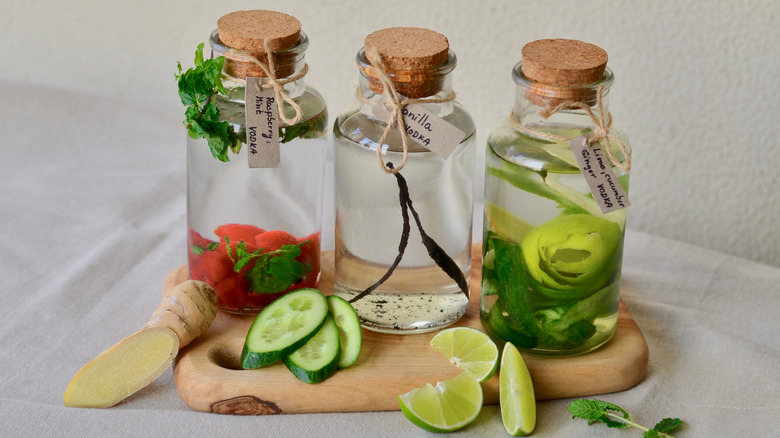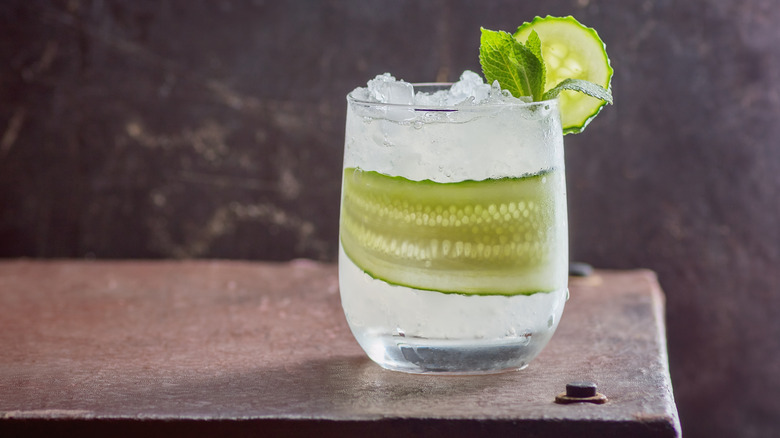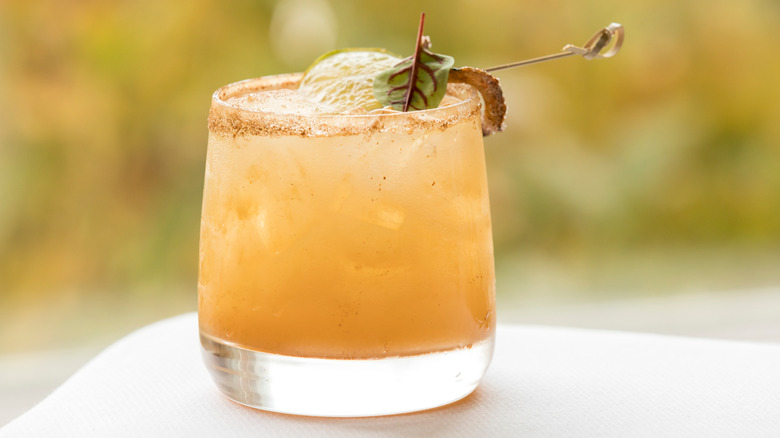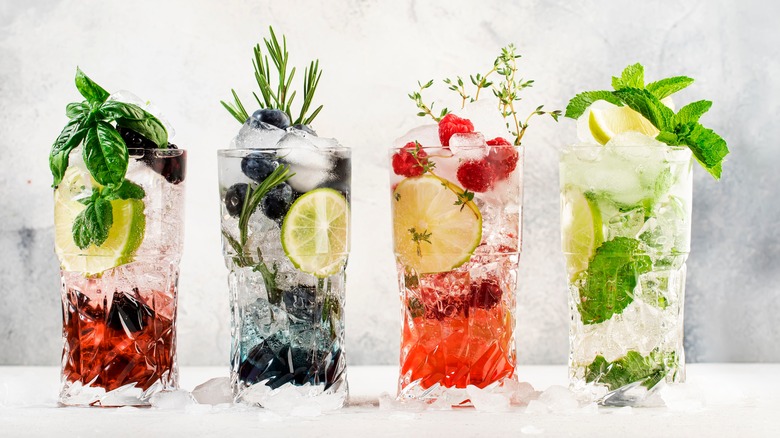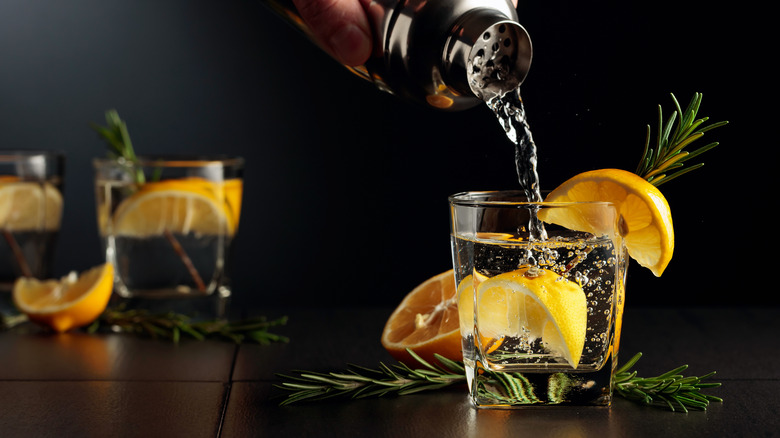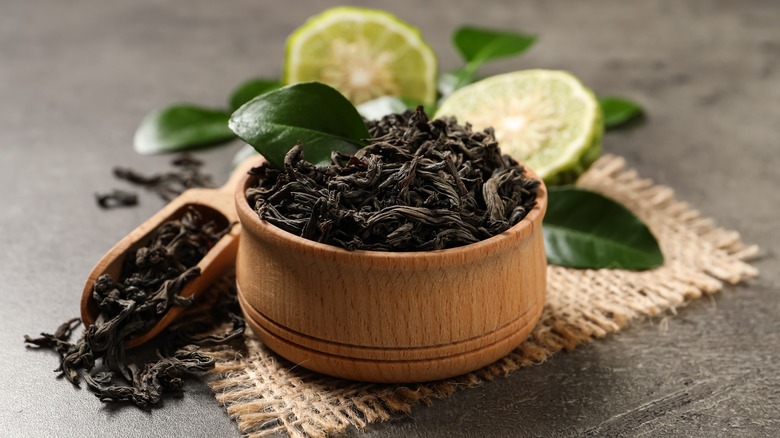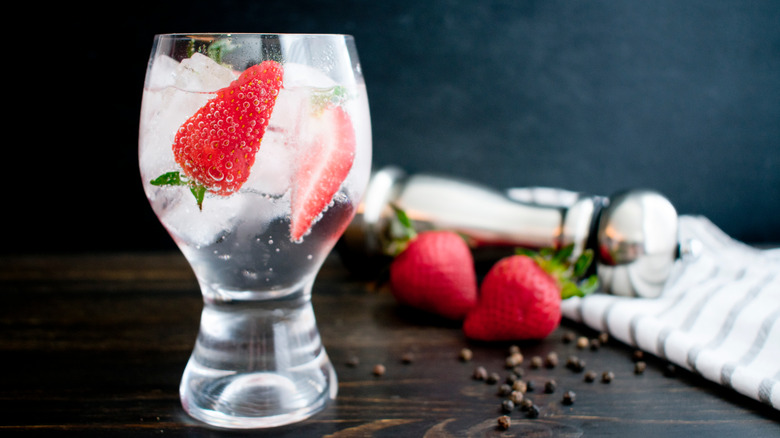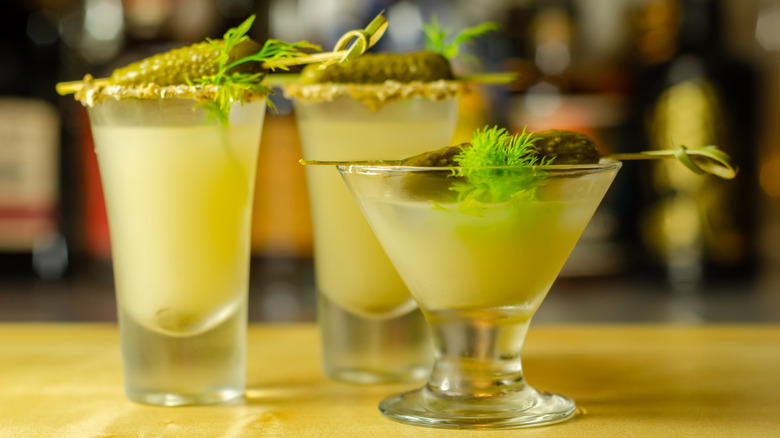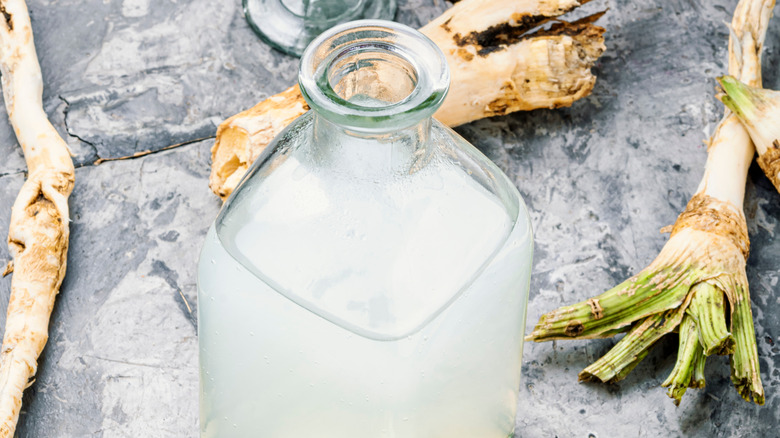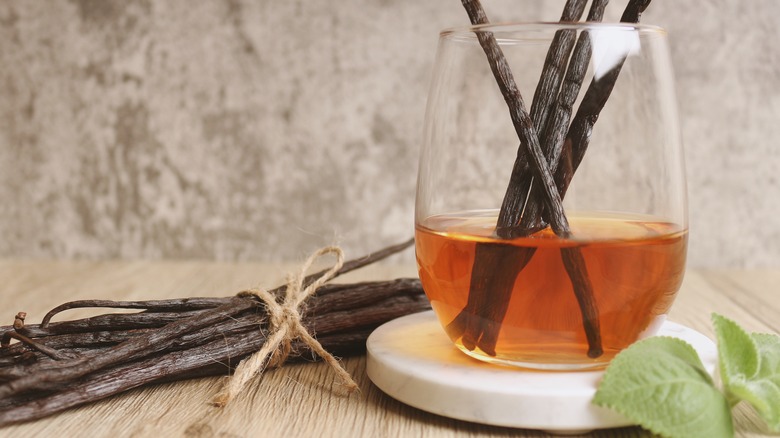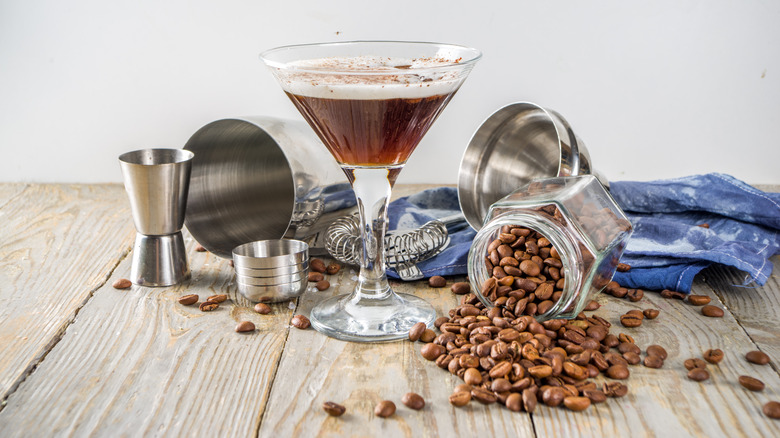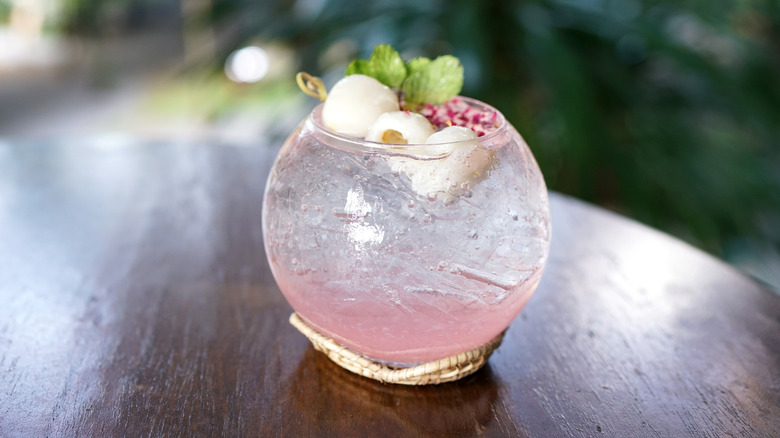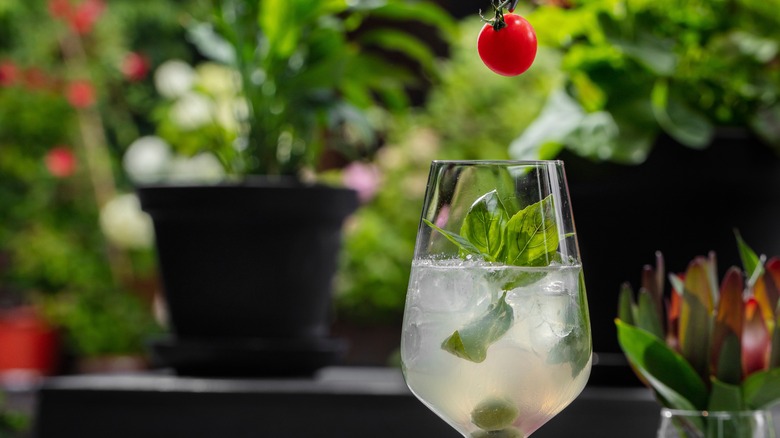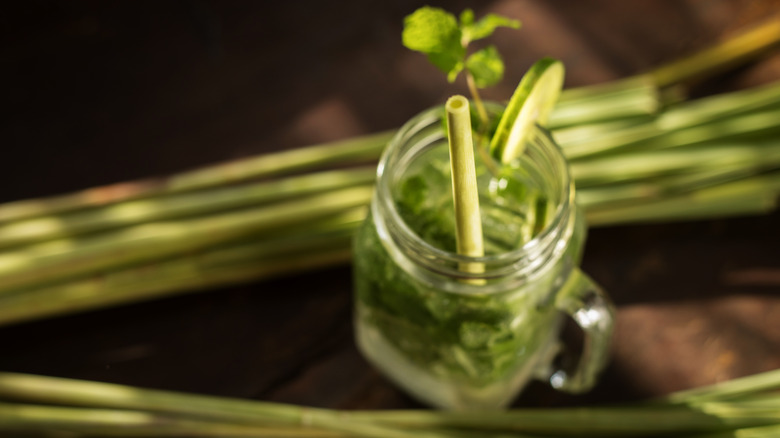13 Vodka Infusions You Need To Start Making
Vodka may have gotten a bad rap over recent years, especially among mixologists and modern cocktail enthusiasts. But the truth is you can't beat its versatility. Vodka's relatively neutral taste, whether it's distilled from grain, potatoes, corn, or fruit, lends it well to many uses and creates a blank canvas upon which other flavors can shine.
One of the best ways to showcase vodka's utility is by making an infusion. Infusing vodka is simple and can be done easily at home. All you need is vodka, a glass jar, and flavoring ingredients. Fresh fruit, dried spices, herbs, roots, flowers, tea leaves — almost anything goes when it comes to infusing vodka. Fill the jar about halfway with your flavorings, then add vodka on top, cover the jar, and let it sit in a cool, dark place. Infusions can take anywhere from a few hours to months, so you'll need to periodically taste the product. When it's ready, strain the mixture through cheesecloth or a coffee filter and enjoy.
For those in a rush, there are higher-tech infusion processes that will speed things up. Using a high-speed blender infuses vodka almost instantaneously. If you have access to a sous vide machine, you can combine the vodka and ingredients in a bag and create an infusion in an hour or two. Whichever method you use, here are some flavor combinations to get you started making custom vodka infusions.
Cucumber and mint
Bracingly refreshing, cucumber and mint-infused vodka makes cocktails perfect for summertime — or anytime you need an invigorating pick-me-up. Because mint and cucumber are best when they're cool, don't use a method that would heat them in any way. So, stay away from the sous vide technique for this flavor combination. Either a simple maceration or blender process will work best.
There are many varieties of cucumbers, and depending on what you have, you will want to treat them differently when making your infusion. English cucumbers are a great option thanks to their sweet flavor and nearly seedless flesh. Along with Persian cucumbers, they have thin skin that doesn't need to be peeled before joining the infusion, as it won't impart bitterness like some other varieties. That category includes garden and Kirby cucumbers, which should be peeled and deseeded first.
You can add chopped cucumber and mint leaves to the vodka together, or keep them separate by using a tea ball infuser or cheesecloth bag for the mint. This method gives you more control over each flavor. Check the infusion periodically until it's to your taste, then use the strained vodka in place of gin to make the most refreshing gimlet you've ever had in your life.
Pumpkin spice
Pumpkin spice drinks needn't be relegated to autumn and shouldn't be limited to just coffee. There's no reason why the combination of warming, comforting spices can't be enjoyed year-round. All it takes is a simple infusion and you can have a supply of pumpkin spice vodka ready to add some fall flair to your drinks no matter the season. The great thing about this homemade infusion is that you can adjust the levels of each component to suit your tastes.
There are five basic ingredients in the classic pumpkin spice mixture: cinnamon, nutmeg, clove, ginger, and allspice. Whole spices are best for infusions as you can easily strain them out. Be sure to use fresh ginger that's been peeled and chopped for the punchiest flavor. It can take a bit of trial and error to find the right balance of spices for your palate, so if you find that a particular spice is too strong or weak, you can strain everything out and craft a new mix. Keep this going until you have the flavor you want.
Pumpkin spice-infused vodka can certainly be used to spike coffee or in place of regular vodka in an espresso martini. For a truly decadent experience, try it in this pumpkin white Russian.
Mixed berries and herbs
Infusing vodka with fresh berries gives you a delicious, fruity spirit. Moreover, it's an easy way to preserve seasonal flavors so you can enjoy them all year long. You can make your berry-flavored vodka even more complex, intense, and flavorful by adding fresh herbs to the mix. There are countless combinations of berries and herbs that you can experiment with, all of which bring a unique character to cocktails.
Basil goes with practically every type of berry, so it's a great addition to a mixed berry infusion. Strawberry, raspberry, blueberry, and blackberry play well with some gently crushed basil leaves. That mix will give you a wonderfully layered vodka so packed with flavor that it can be enjoyed on its own, served chilled in a martini glass, or enjoyed on the rocks topped with soda. If you want to keep things simple, blueberry and lavender or blackberry and sage both make a great pair. Meanwhile, thyme makes a fantastic partner for strawberries and raspberries' tartness matches up well with intense fresh herbs like oregano. Try different combinations of your favorites — the possibilities are nearly endless.
Citrus and herbs
Citrus-infused vodkas are some of the most versatile flavored spirits around. They can be made even more flavorful with the addition of fresh herbs. Many combinations of citrus fruits and herbs go well together, each ingredient complementing and enhancing the others' flavors and aromas to create a beautifully complex spirit that can be used in a wide variety of cocktails.
When making a citrus-infused vodka, start with fresh, clean citrus. Since the outer rind is what you'll be using, peel carefully to avoid the bitter white pith underneath, which can ruin the flavor of your vodka. You can mix citrus peels to get a more layered, complex flavor — lime and grapefruit make a zesty, refreshing pair, and Meyer lemon and orange combine well for a sweeter vodka.
Once you have your citrus, choose herbs that will complement them. Dill and thyme go great with lemon. Lime likes cilantro and basil. Rosemary and orange make a great pair. Fresh mint and grapefruit will give you a super-refreshing vodka. Start with a few simple pairings and work your way up to more intricate, complex combinations of citrus and herbs. Use citrus herb-infused vodka for a unique take on a classic vodka martini.
Earl Grey tea
Infusing vodka with tea is one of the simplest ways to add intense, complex flavors to the spirit. Any type of tea can be used to add its own unique character, so feel free to experiment with your favorites. Tea bags or loose leaves both work well here, as tea is made to be steeped in liquid, so its flavors transmit easily into the vodka. Thus, tea infusions can be made relatively quickly, typically taking less than a day to get a good flavor intensity.
What makes Earl Grey tea such a wonderful ingredient for a vodka infusion is that its signature ingredient is bergamot, a unique citrus fruit. This makes the tea-flavored vodka particularly suitable for cocktails, as it matches well with other citrus ingredients. Bergamot is an intensely aromatic fruit, and this fragrance can be enhanced even more by adding some fresh bergamot peels to your infusion in addition to the tea. The fruit is only in season for a short time, so keep your eyes peeled during winter months for this special citrus. Try it in this greyhound recipe.
Strawberry and black pepper
Strawberries and black pepper may seem like an odd combination at first, but be assured these two very different ingredients are a potent pair when it comes to flavor. The piquant heat of freshly cracked black peppercorns brings out the natural sweetness of a lush, perfectly ripened strawberry, creating an intense pop of flavor. Once you try the two together, you may never eat a strawberry sans pepper again.
When infusing vodka with strawberries, make sure that the fruits have been thoroughly cleaned and the leafy tops are removed. Only use ripe strawberries, as green or underripe berries will add a tart, grassy flavor. Toasting the peppercorns adds a nice layer of extra warmth to the infusion. Unlike some fresh ingredients that become unpleasant when cooked, strawberries can take on heat, so you can use the sous vide method or even roast your strawberries before creating a traditional infusion. With this last method, the fruit will take on a rich, jammy flavor. This infused vodka works beautifully in this sparkling chateau strawberry cocktail.
Dill pickle
If your palate leans more in the savory direction than the sweet, dill pickle-infused vodka may be the spirit you've been looking for. Pickling spice mix is easy to put together using whole spices, and by doing it yourself you can customize the mixture to suit your palate. The addition of herbs and other fresh ingredients lifts and enhances the flavors of the spice mix to create a symphony of savory flavors.
Pickling spice typically includes peppercorns, mustard seeds, coriander, bay leaves, cloves, allspice, and red pepper flakes. Other ingredients like cinnamon, cardamom, and ginger can be thrown into the mix as well. To make your infusion take on the dill pickle flavor, you can add both dill seeds and fresh sprigs of dill to the vodka. Garlic is up to you — it may be too intense for some palates, but a necessity for others. Simply add peeled cloves, just as you would when making a pickle brine. Hot peppers can also be added if you like you're partial to a spicy pickle flavor.
Dill pickle vodka is so flavorful it can easily be enjoyed on its own, as a refreshing chilled shot, or stirred with a dash of vermouth to make a savory martini variation. You can even add pickle brine to make a dirty pickle martini with a double dose of pickle flavor.
Horseradish
Horseradish-infused vodka is rather common in some parts of the world, most notably in Ukraine and Russia, where it's known as khrenovukha. Some believe it to have medicinal properties, and while this may be an exaggeration, the vodka's intensity is sure to wake you up and clear your sinuses. This reaction is thanks to a chemical compound found in horseradish known as allyl isothiocyanate. This is highly volatile and vaporizes quickly, filling your sinuses with its pungency. Combined with the burning sensation of alcohol, horseradish vodka is a force to be reckoned with and not for the faint of heart.
Using fresh horseradish root is the best way to infuse vodka with its flavor, as the processed jarred stuff typically has other ingredients added, including flavorings and preservatives. The root's tough exterior should be peeled to expose the flavorful inner flesh, then sliced or chopped and added to the vodka. Horseradish is an intense flavor, so it's important to taste this vodka frequently to know exactly when it reaches the level of heat and flavor that you're seeking.
Obviously, this is the perfect vodka to use in a spicy bloody Mary to add extra oomph to the classic brunch drink. It's also a good thing to have around the next time you have a stuffy nose.
Vanilla bean
Vanilla vodka is one of the most popular commercially-produced flavors out there, and it's not hard to understand why — vanilla is a delicious, luxurious, and versatile ingredient. But if you want to stay away from mass-produced products that use artificial vanilla flavoring, you're in luck, because making a vanilla bean-infused vodka at home is extremely easy. The only drawback is the expense, as vanilla beans are not cheap. However, the payoff of having pure, clean, and natural vanilla flavor in your infusion is well worth the cost and minimal effort.
There are several varieties of vanilla beans to choose from. Vanilla is native to Mesoamerica, and Mexican vanilla beans are still considered the finest quality. Thick and flavorful, these particular beans will give your vodka great depth and intensity. Tahitian beans exhibit a more delicate, aromatic quality. Madagascar vanilla beans have a strong if not particularly complex flavor. Less-commonly found Uganda beans are extremely rich and sweet.
You'll only need one or two beans to infuse a bottle of vodka. Slice down the middle of the pod, but not all the way through as you don't want to lose any of the flavorful interior. After a few days, your vodka will turn a gorgeous honeyed amber color and will be filled with pure vanilla goodness, ready to upgrade your dessert cocktails and more.
Coffee
If the buzz from your morning coffee isn't enough to keep you going all day, you can add some extra pep to your evening cocktail by crafting some coffee-infused vodka. Not to be confused with coffee liqueurs, which are sweet and typically include other dessert-type ingredients, coffee vodka can be just as bracing and stimulating as a piping hot cup of morning joe.
The final flavor of a coffee vodka infusion depends on the beans you use, so choose your variety carefully. Are you more of a smooth, light roast arabica fan? Or do you prefer the rich strength of a dark roast robusta? Any type of bean will work, so it's up to your tastebuds to decide. Once you've got your beans, put them in a bag and give them a rough crush with a heavy object before combining them with the vodka — this will let the flavor compounds of the beans get in direct contact with the spirit.
The longer the beans steep, the stronger your coffee vodka will taste. Give it a test after 12 hours or so to see how it's progressing. Coffee vodka is clearly great in an espresso martini or a white Russian cocktail.
Lychee and rose
The combination of lychee and rose creates a stunningly-perfumed, romantically-hued vodka infusion that brims with intoxicating aromas and flavors. While you can find rose and lychee extracts and concentrates, using the actual fruits and petals will give you fresh, natural flavors that can't be achieved otherwise.
Indigenous to southern China, the tropical lychee fruit can be found fresh at many Asian markets (if you can't find them fresh, canned lychees will work in a pinch). They have tough red skin and a large pit to work around to get to the tender, juicy flesh, which you can chop and add to your vodka. The lychees will take longer to impart their flavor than the rose, so you may want to give the fruit a few days with the vodka before you add the floral component.
For the rose element, if you're using fresh petals, make sure they're organically grown to avoid pesticide contamination. You'll want to thoroughly wash and dry them before adding them to your mixture, too. Otherwise, there are many food-grade edible dried rose petals available to purchase that will work perfectly. Rose can be a strong scent and flavor, so use it with caution and make sure you're tasting your infusion daily to get the flavor balance just right. Lychee and rose vodka is delightful when it's simply topped with sparkling wine.
Tomato and basil
You may think of them more as ingredients suited to a pizza, but basil and tomato make a great combination in drinks, too. While herbs like basil are easy to infuse in vodka, tomatoes can seem like a more challenging ingredient, but the truth is that you can treat them just like any other fruit. Make sure you're using super-ripe, in-season tomatoes to get the most flavor, and that your basil is likewise fresh and lively. A few brown spots on your basil can be okay, but if it's limp, really off-color, or smells odd, it's best to toss it — those characteristics can ruin your entire infusion.
A tomato is over 90% water which can make the resulting vodka seem thin and its flavors subtle. If you like a lighter, less intense style, this could be a good thing. But if you're looking for punchier flavors, experiment with using different types of tomatoes. Smaller tomatoes have less watery flesh and tend to be more flavorful. Try sun-dried tomatoes for a sweeter flavor, or smoked or roasted tomatoes to add layers of depth and concentration. Tomato and basil-infused vodka makes a delicious savory martini — make sure to garnish with an olive.
Lemongrass, makrut lime, and ginger
The complex flavors of Thai cuisine come together in beverage form when you infuse vodka with lemongrass, makrut lime, and ginger. Fresh makrut limes can be hard to find, but it's the leaves you want for your infusion, which are super fragrant with a bright, citrusy aroma tinged with floral notes. You can find them in dried form, similar to bay leaves. If you do come across fresh makrut limes, you can add the peeled rind to your infusion, too.
To prepare lemongrass for the infusion, trim the ends and remove the woody outer layer if necessary. You can leave the sticks whole, or chop them into smaller pieces, while lightly crushing them will help them release flavor quickly. Peeled and chopped ginger is the final ingredient in this trio, adding its unique spicy heat to the mix. Together these flavors create a bright, heavily aromatic, complex, and intriguing vodka that makes a great ingredient in a mule — a Moscow mule by way of Bangkok. It also works well in vodka-based tiki drinks and any cocktail that involves coconut. If you like things spicy, you can also add bird's eye chiles to this infusion.
